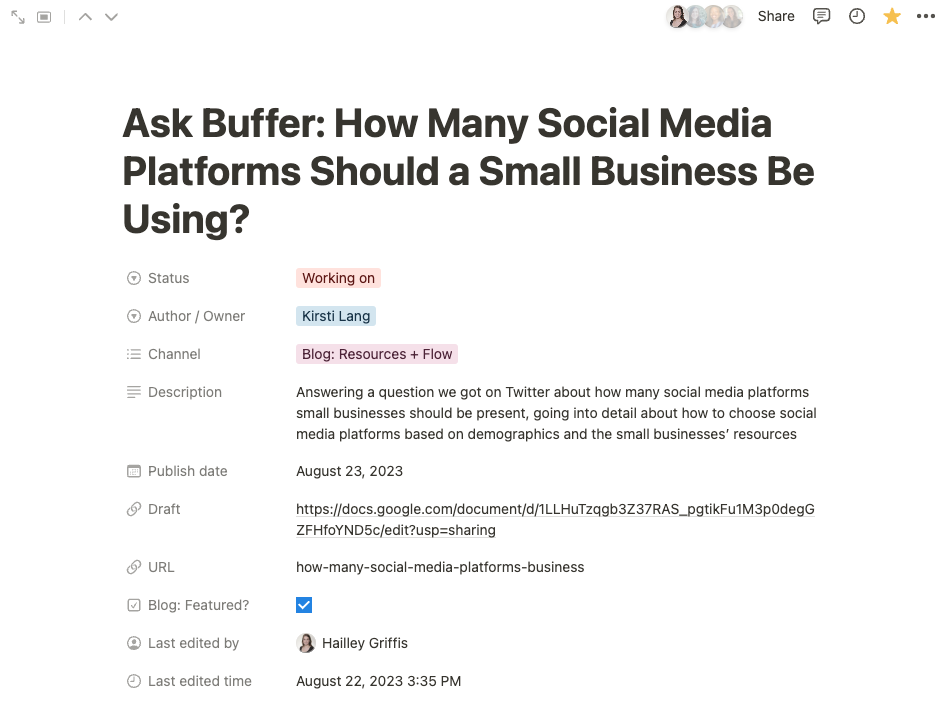
How Buffer’s Content Team Collaborates + Our Content Calendar Template
Head of Communications & Content @ Buffer
The world of social media and content marketing is a fast-moving space. Any individuals or teams working in those worlds know how essential it is to have the right tools in place to make everyday work flow more smoothly.
At Buffer, not only are we writing and publishing blog and social media posts every day, we’re also a fully remote and distributed company. For our Content team, in particular, we’re four people spread out across three timezones. The nature of our overlap and flexible work schedules means we need to stay even more organized, on top of what is being published and when, and keep all the most important information in one space.
Enter our content calendar.
Our Content team publishes at least four articles a week, one for Monday through Thursday, plus we regularly refresh older content and send a weekly newsletter. We also publish to social media every day of the week across six social media platforms. Add all of this up, and it means the only way to keep track of everything is to keep it in one place with a centralized content calendar.
We work from a content calendar built in Notion, and in this post, we’ll go over how we work together as a content team, exactly how our content calendar is set up, and we’ll share a free template of our very own content calendar in Notion that you can duplicate and start using immediately.
How we work together
How we collaborate as a team has evolved a lot over the years, and it’s still changing regularly. (Here’s a throwback to how our team worked together back in 2017.)

We keep an open mind and try to question our own processes to see where they can be improved. Plus, by sharing our own systems transparently (like in this post!), we often get great feedback from our community and can make adjustments and improvements.
The tools we use
Tools are the infrastructure behind any team, so here are all of the tools we use and what we’re using them for.
- Content Management System: Ghost
- Content Calendar and Planning: Notion
- Blog post drafts: Google Docs
- Graphics and charts: Canva
- Progress updates and check-ins: Slack
- SEO research and URL planning: Ahrefs
- SEO-optimization: Clearscope
- Traffic and content performance: Mixpanel
How we divide ownership
We’re a small and nimble team made up of Mitra, our Social Media Manager, Tami and Kirsti, our two Content Writers; and myself as our Head of Content. We also work with a content agency that produces roughly four posts monthly and one freelancer who produces two content refreshes every month. At larger companies, there are entire teams dedicated to editing blog posts and who focus on publishing — not so for us.
Buffer, as a company, is a place where there’s a lot of flexibility and freedom with the expectation that you own your projects and drive your work forward. It’s the same on our Content team — we collaborate on our content calendar to decide what we publish and when, but every individual “owns” the Notion cards for the posts they are working on and is responsible for keeping them up to date and letting the rest of the team know how progress is going.
How we collaborate
As a distributed team that works remotely and a team that has a high output, we try to avoid too many meetings so there is plenty of time for heads-down work, like writing and batch-filming video content. Even so, we do have regular team meetings to stay aligned.
- Editorial Review: Every two weeks, we have an editorial meeting to review the next two weeks of content, check in on timelines, ensure that we have enough variety and cover any timely topics, and plan for upcoming vacations.
- Content team meetings: Twice a month (beginning and mid-month), we do content team calls where we review all of our metrics for the last month, reflect on what’s working and what isn’t, and iterate from there.
Outside of meetings, we keep up a steady stream of threads in our content team channel in Slack, where we get feedback from each other, share ideas, and celebrate wins.

We also collaborate directly in Notion to leave comments — most of the comments for blog posts happens in the Google Doc where the outline and then draft live, but for social media posts we rely on Notion to go back-and-forth with ideas and suggestions.
How a piece of content goes from idea to published
Our system has been working really well for us to take ideas to content that we’re sharing and publishing. Here’s each step of our content creation process:
Adding a card to Notion
Every idea starts as a card in Notion. We’ll also create and add cards for events that are already planned and have content associated with them — things like product launches.
Adding a date to start planning
Some cards get dates immediately, and for others we wait until it’s closer to when we’ll want to publish them. Mitra keeps several weeks of content ideas planned out at a time, for example, and still keeps ideas in Notion as well. On the blog side, we’ll go over ideas and add dates in the Editorial meeting for the blog content calendar to make sure we have the next two weeks fully planned out.
Drafts and reviews
Every piece of content is reviewed. Content is either peer-reviewed or fully edited before it goes out on social or on the blog.
Schedule
It won’t come as a surprise that we love scheduling our content out in advance – our goal is to schedule all of our content for the blog the day before at the latest, and Mitra schedules social posts at the end of the week for the following week.
Post-publishing, we track a whole host of metrics, and blog and social post-performance are reviewed monthly.
Our content team principles
There are three principles that we keep top-of-mind on the content team for our work since everything we create reflects Buffer as a company and as a brand. They are:
- Add value. We don’t create just to create; we have something to say, and we want to help our community and customers. Part of adding value is consistency. We will show up consistently for our customers and community with high-quality content.
- Be Buffery. Our content should look and feel like it’s coming from the Buffer team — a big part of that is voice and tone. Buffer posts sound different from posts any other company might write, and another part of that is the content itself. We should have our own unique opinion and approach for every topic.
- Build in public. What we share on the Buffer blog and social channels is one of the main ways we can help our whole company continue to build in public. We can help facilitate this by pushing to post things early into our journey of talking about it at Buffer, not waiting until something is complete. We can encourage teammates to participate in blog posts and social posts to share their work and help be the catalysts for more of a culture of building in public at Buffer.
How our content calendar is set up
Central to our collaboration as a content team is this one database in Notion, our content calendar, where every piece of content we’re going to publish exists in one card with a whole host of information about it.
Here’s what a full week of our content team calendar looks like:

At the top of this, you can see that we have different views set up. The main ways to view the database are:
- The whole calendar
- The calendar filtered for only blog posts
- The calendar filtered for only social media posts
- A board view to see content based on status
- A list of ideas for blog post content
Within Notion, you can get very specific about the properties you set up. Here are all of the properties we use for our content calendar.
How we manage blog posts
For blog posts, our main properties are:
- Status (Idea, Planned, Working on, Drafted, In Review, Ready to be scheduled, Scheduled, Published, Paused)
- Author/Owner
- Channel (blog or social media platform)
- Description (what is the post about?)
- Publish date
- Draft link (to a Google doc)
- URL (what will the URL of this blog post be?)
- Featured? (a checkbox to determine if we feature a post)
- Last edited by (automatically updates who last edited the card)
- Last edited time (automatically updates the last time the card was edited)

How we manage social posts
For social posts, our main properties are:
- Status (Idea, Planned, Working on, Drafted, In Review, Ready to be scheduled, Scheduled, Published, Paused)
- Author/Owner
- Channel (which social media platform)
- Publish date
- Graphics (link to any graphics created)
- URL (link to the blog post)
- Last edited by (automatically updates who last edited the card)
- Last edited time (automatically updates the last time the card was edited)

The goal for all of these properties and for this database is to balance including all of the essential information alongside making this a lighter lift so that we can keep this system running and up-to-date as a team without it taking too much time every week.
Our content calendar template
We have a simplified version of our very own content calendar available as a template that you can duplicate to your own Notion space here.
We recommend using Notion’s filters to customize the views to whatever you’d use most and, of course, adding in any other properties that will be useful for your team.
Pass this along to anyone keen for a better system for their content, and leave a comment with other templates you’d like to see from us, plus anything else we can answer on how we collaborate!
Try Buffer for free
140,000+ small businesses like yours use Buffer to build their brand on social media every month
Get started nowRelated Articles

Sending ads by mail may seem like a thing of the past, but this marketer thinks it’s a surprisingly effective approach for e-commerce brands.

In this article, we'll explore the unique characteristics of organic and paid social media, how they complement each other, and why incorporating both into your social media strategy is essential for achieving your business goals.

Whether you’re a full-time content creator, micro-influencer, nano-influencer, or just getting started, here’s how to create your own influencer media kit.